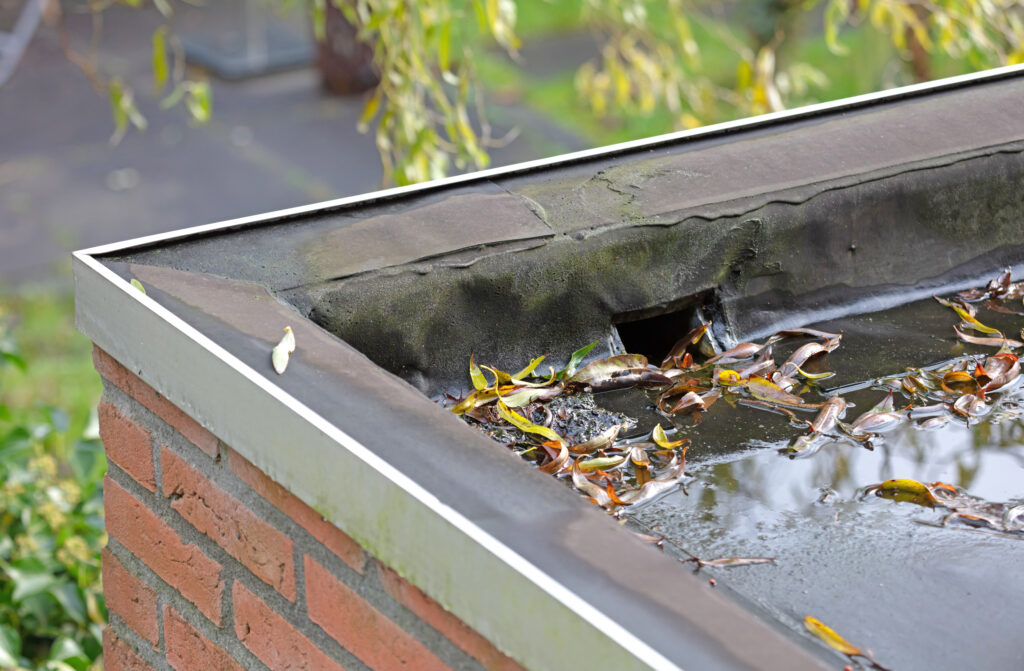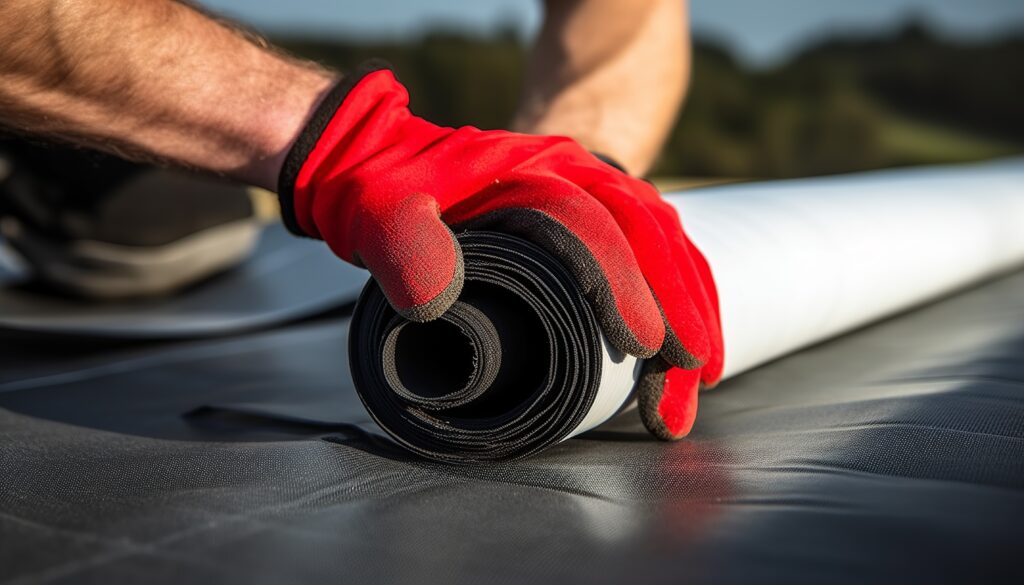The perks of flat roofs are numerous, but low maintenance isn’t one of them. They require frequent repairs. Otherwise, damaged patches allow water into your home, and leaks cause mold, flooding, and wood damage.
With such dire consequences, flat roof repairs should always be a priority. Roofing companies like Paramount Exteriors understand your urgency. So call us to get a quote and get your roof fixed.
Understand the Damage Cause
Roof damage happens because of any of the following:
- Natural Disasters: Natural disasters include hurricanes, tornadoes, electrical storms, snowfalls, rainwater, and floods.
- Heavy Weather: High winds and extreme weather can wear down your roofing.
- Age: Around the end of your roof warranty period, it may start to fall apart naturally.
- Impact: Impact damage can happen due to fallen tree branches, hitting surrounding objects, and other debris.
- Thermal Movement: If your roofing construction doesn’t support the natural expansion and contraction of materials due to temperature level changes known as thermal movement (like oxidized bitumen), roofing membranes develop splits, blisters, and cracks.
- Poor Installation or Design: Poor installation can render your roof highly prone to leaks and damage. It can lead to delamination: the separation of your flat roofing layers, which is damaging. This is why hiring a top-notch roofing service is worth it.
By identifying the cause of the damage, you can assess whether insurance will cover the repair costs. Natural disasters and unexpected events (like storm damage) are typically covered.
A roofing service can support you with insurance claim knowledge, put together your insurance claim, and work with your insurance company to restore your property.
Otherwise, damage due to other causes may fall under “wear and tear,” so you’ll probably need to pay for it yourself.
Look for the Warning Signs

Flat roof damage can make itself known through the following signs:
- Indoor mold and mildew odors
- Watermarks and mold spots on ceilings
- Roof cracks
- High energy bills
- Slightly wet dark brown patches on your ceiling
- Flat roof dipping or sagging
- Low spots in your flat roof where water has accumulated, putting stress on your home’s structure
- Peaking, creasing, or pulling up in the roofing material
- Expired lifespan, as roofs over 10 to 15 years old are due for a replacement
- Seam blisters
- Discoloration in patches of spray polyurethane foam (SPF) roof
- Cracks or gaps in the flashing
Find the Flat Roof Leak
You may locate the roof leak inside your house, but it may not necessarily correlate to a water entry source that’s directly above it on the roof.
The reason is that flat roofs use membranes. With membranes, water can spread across them in any direction and slip into the layers of your home’s interior through any weak spots. These spots could be seams where you’ve fixed HVAC units, pipes, chimneys, flashing, and vents with any openings.
Accordingly, you’ll need to climb and inspect the roof. Ideally, you should wait till the roof has been dry for 72 hours. Evenings are best because the temperature decreases, so steam gets released from underneath into the source of the flat roof leak, which is a helpful sign. Also, inspect low spots surrounded by rings of dirt, as water might pool inside.
You may be unsure if a particular spot is the leak source, which is why you should try this simple test. Spray the area with a hosepipe, and go back into your home. If your suspicions are correct, water will leak through. Note that it might take a while, as the water will have to travel through various roofing layers.
Determine the Needed Materials

The most commonly used roof repair materials for flat roofs are as follows:
EPDM
Ethylene propylene diene monomer (EPDM) rubber is used in the United States and worldwide. It’s a highly durable rubber roofing material composed of propylene and ethylene. It’s easy to work with (like patching up a punctured car tire).
BUR
Also called tar and gravel roofing, built-up roofing (BUR) has been around for over a century. It’s the product of combining layers of bitumen and reinforced fabrics to form a watertight membrane and seal on your roof.
Modified Bitumen
Modified bitumen is a mixture of asphalt, rubbers, and solvents that are heat-sealed via torch-down roofing.
PVC
Polyvinyl chloride (PVC) flooring is composed of two PVC roofing material layers with polyester in between. This membrane contains additives that give your roofing malleability, flexibility, and UV rays protection and prevents curing.
TPO
Thermoplastic polyolefin (TPO) roofing material is a single-ply sheet composed of polypropylene and ethylene-propylene rubber. Experts polymerize and mechanically attach or affix it to a roof via a reflective membrane.
Devise a Solution
With the leak located and materials gathered, we can switch to problem-solving mode. This step is where you determine if you should repair or replace your flat roof so that you can save money long-term.
Ask yourself the following questions to assess your roof’s condition:
- Is your roof mostly in good condition?
- Is the damaged area small? Can you patch it up?
- Is this wind or hail damage?
- Is your roof well within the warranty period?
Repair
If you answer yes to most of the questions, a flat roof repair should suffice (as long as it’s a good repair job). And the severity of the damage will determine if the repair can be a DIY project or one for expert roofers.
Surprisingly, flat roof repairs are typically more time-consuming than replacements, which makes them more expensive.
Replacement
If you’ve answered no to these questions, a roof replacement may be in order. Signs that your roof is in bad enough condition to justify a replacement are:
- Membrane, flashing, or seams damage in various patches
- Several leaks
- Water constantly pooling in some spots
- Impact damage (from tree branches and other debris forms)
As for the roof’s warranty life, it typically ranges from five to 20 years. If your roof’s life expectancy is over, it’d be smart to replace it, especially in cases where the roof damage is the result of age and material breakdown. Otherwise, leaks tend to happen often for that reason.
Repairing the roof might turn out to be more expensive than replacing it. There may be structural issues that you can’t patch up. And if you ignore them, mold or rot will spread into your house, causing more damage.
Luckily, roofing experts can replace your roof. They’ll remove and replace your old membrane, rotted fascia and plywood, damaged vents, and more. Also, they may replace your insulation.
Repair Your Flat Roof
If you’re going down the repair route, you can make the necessary fixes yourself as long as they’re minor or call an expert roofing service for more serious damage.
DIY Repair
Suppose you have a patch that you’d like to repair, wear latex or other waterproof gloves and safety glasses (for safety purposes). Then, carefully climb onto the roof with a sturdy ladder; another person should hold it steady. Next, apply a bead of caulking (a type of waterproofing paint) on the identified leak source. Sealing over the leak source with it is good for a temporary fix.
Otherwise, you can patch up the area with a product that matches your roof’s membrane (like roofing tar for modified bitumen). If your roof’s material is EPDM rubber, you’ll need to heat-seal the patch with a heat gun or adhesive.
Professional Repair
We know hiring a professional roofing service for a roof replacement is important, but when is it needed for a repair?
We recommend calling the experts in the following cases:
- You have TPO or PVC roofing, as they need to be heat-sealed and are tricky to handle.
- Your roof has rips in its seams and a punctured membrane.
- Large sections of your decking are damaged or rotten.
- Water is pooling in large areas.
- You can’t pinpoint the leak source.
- You don’t have the required tools and materials for the repair.
Final Thoughts
Ultimately, you should start by assessing your circumstances, including the damage caused, leak sources, and damage extent, to determine how you can proceed.
Contact Paramount Exteriors to get a quote and repair your roof. We work with all roofing materials and only use IRC/NARC specifications for roofing codes, so you can rest assured that our services will satisfy and even exceed your expectations!
